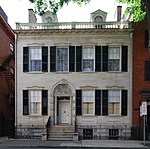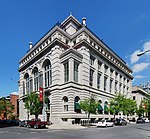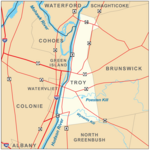Rensselaer County Historical Society
Buildings and structures in Troy, New YorkHistoric districts on the National Register of Historic Places in New York (state)Historic house museums in New York (state)Historical societies in New York (state)Houses on the National Register of Historic Places in New York (state) ... and 5 more
Individually listed contributing properties to historic districts on the National Register in New York (state)Museums in Rensselaer County, New YorkNRHP infobox with nocatNational Register of Historic Places in Troy, New YorkRensselaer County, New York
The Rensselaer County Historical Society (RCHS) is a non-profit, historical society and museum, to promote the study of the history of the Rensselaer County, NY. RCHS was founded in 1927, and originally operated out of a single room in the Troy Public Library, collecting manuscripts and published materials related to the county's history. It is located in the Central Troy Historic District, in Troy, NY. The Rensselaer County Historical Society operates a museum, and offers public programs from its location at 57 Second Street, Troy, NY.
Excerpt from the Wikipedia article Rensselaer County Historical Society (License: CC BY-SA 3.0, Authors).Rensselaer County Historical Society
2nd Street, City of Troy
Geographical coordinates (GPS) Address Nearby Places Show on map
Geographical coordinates (GPS)
| Latitude | Longitude |
|---|---|
| N 42.728055555556 ° | E -73.691944444444 ° |
Address
Troy City Library
2nd Street 100
12180 City of Troy
New York, United States
Open on Google Maps









